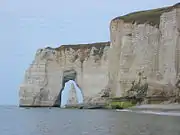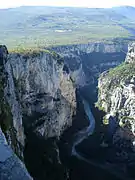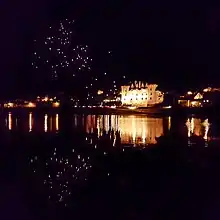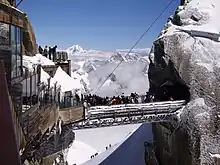Tourism in France
Tourism in France directly contributed 79.8 billion euros to gross domestic product (GDP) in 2013, 30% of which comes from international visitors and 70% from domestic tourism spending. The total contribution of travel and tourism represents 9.7% of GDP and supports 2.9 million jobs (10.9% of employment) in the country.[1] Tourism contributes significantly to the balance of payments.
France was visited by 89 million total foreign tourists in 2018, the most of any country in the world.[2] France has 37 sites inscribed in the UNESCO's World Heritage List and features cities or sites of high cultural interest (Paris being the foremost, but also Loire Valley, Toulouse, Strasbourg, Bordeaux, Lyon and others), beaches and seaside resorts, ski resorts, as well as rural regions that many enjoy for their beauty and tranquillity (green tourism). Small and picturesque French villages of quality heritage (such as Collonges-la-Rouge, Locronan, or Montsoreau) are promoted through the association Les Plus Beaux Villages de France (literally "The Most Beautiful Villages of France"). The "Remarkable Gardens" label is a list of the over two hundred gardens classified by the Ministry of Culture. This label is intended to protect and promote remarkable gardens and parks.
Statistics
Most tourists arriving to France in 2014 came from the following countries or territories:[3]
| Rank | Country or territory | Number of tourists |
|---|---|---|
| 1 | 68,436,000[3] | |
| 2 | 6,200,000[3] | |
| 3 | 3,169,000[3] | |
| 4 | 1,661,000[3] | |
| 5 | 1,542,000[3] | |
| 6 | 1,001,000[3] | |
| 7 | 784,000[3] | |
| 8 | 678,000[3] | |
| 9 | 400,000[3] |
Number of stays
In 2014, tourists from the following countries spent the most nights in France:[3]
| Rank | Country | Number of nights |
|---|---|---|
| 1 | 86,400,000 | |
| 2 | 79,700,000 | |
| 3 | 59,500,000 | |
| 4 | 43,600,000 | |
| 5 | 42,700,000 | |
| 6 | 34,700,000 | |
| 7 | 33,600,000 | |
| 8 | 27,600,000 | |
| 9 | 12,000,000 | |
| 10 | 11,000,000 | |
| 11 | 10,200,000 |
Touristic regions
Paris
.jpg.webp)
Paris, the capital city of France, is the third most visited city in the world.[4]
It has some of the world's largest and renowned museums, including the Louvre, which is the most visited art museum in the world, but also the Musée d'Orsay which, like the nearby Musée de l'Orangerie, is mostly devoted to impressionism, and Centre Georges Pompidou, dedicated to Contemporary art.
Paris hosts some of the world's most recognizable landmarks such as the Eiffel Tower, which is the most-visited paid monument in the world,[5] the Arc de Triomphe, the cathedral of Notre-Dame, or the Sacré-Cœur on Montmartre. The Cité des Sciences et de l'Industrie, located in Parc de la Villette, is the biggest science museum in Europe.[6] Near Paris are located the Palace of Versailles, the former palace of the Kings of France, now a museum, and the medieval village of Provins. Both attractions are protected as UNESCO World Heritage Sites.
French Riviera

With more than 10 million tourists a year, the French Riviera (French: Côte d'Azur), in Southeastern France, is the second leading tourist destination in the country, after the Parisian region.[7]
According to the Côte d'Azur Economic Development Agency, it benefits from 300 days of sunshine per year, 115 kilometres (71 mi) of coastline and beaches, 18 golf courses and 3,000 restaurants.[8] Each year the Côte d'Azur hosts 50% of the world's superyacht fleet, with 90% of all superyachts visiting the region's coast at least once in their lifetime.[9]
Main cities on the French Riviera include Nice, Antibes and Cannes; Cap Ferrat is also a popular destination. Cannes hosts the annual Cannes Film Festival. Tourists often visit Port-Cros National Park, east of Toulon, as well as the city-state of Monaco, famous for its Monte Carlo Casino, near the Italian border.
Provence

A large part of Provence, with Marseille as its leading city, was designed as the 2013 European Capital of Culture. Numerous famous natural sites can be found in the region, as the Gorges du Verdon, the Camargue, the Calanques National Park and the typical landscape of Luberon. Provence hosts dozens of renowned historical sites like the Pont du Gard, the Arles' Roman Monuments or the Palais des Papes in Avignon. Several smaller cities also attracts a lot of tourists, like Aix-en-Provence, La Ciotat or Cassis, on the Mediterranean Sea coastline.
Loire Valley

Another major destination are the Châteaux (castles) of the Loire Valley. The French Revolution saw a number of the great French châteaux destroyed and many ransacked, their treasures stolen. The overnight impoverishment of many of the deposed nobility, usually after one of its members lost his or her head to the guillotine, saw many châteaux demolished.
During World War I and World War II, some chateaux were commandeered as military headquarters. Some of these continued to be used this way after the end of the Second World War.
This World Heritage Site is noteworthy for the quality of its architectural heritage, in its historic towns such as Amboise, Angers, Blois, Chinon, Orléans, and Saumur, but in particular for its castles, such as the Châteaux d'Amboise, de Chambord, d'Ussé, de Villandry, de Chenonceau and de Montsoreau, which illustrate to an exceptional degree the ideals of the French Renaissance.
French Alps
The French Alps are the portions of the Alps mountain range that stand within France, located in the Rhône-Alpes and Provence-Alpes-Côte d'Azur regions. While some of the ranges of the French Alps are entirely in France, others, such as the Mont Blanc massif, are shared with Switzerland and Italy.
More than 20 skiing resorts make it a popular destination among Europeans in the winter.
Corsica

Corsica is the fourth largest island in the Mediterranean Sea after Sicily, Sardinia and Cyprus. It is a popular attraction for tourists with both cultural aspects (with its main cities Ajaccio and Bastia and smaller towns like Porto-Vecchio and Sartène) and geographical features (Parc naturel régional de Corse).
The Calanques de Piana and Scandola Nature Reserve are listed on the UNESCO World Heritage List. The island is 183 kilometres (114 miles) long at longest, 83 kilometres (52 miles) wide at widest, has 1,000 kilometres (620 miles) of coastline, more than 200 beaches, and is very mountainous, with Monte Cinto as the highest peak at 2,706 metres (8,878 feet) and around 120 other summits of more than 2,000 metres (6,600 feet).
Mountains comprise two-thirds of the island, forming a single chain. Forests make up 20% of the island.
Notable places
Cities
France has many cities of cultural interest, some of them are classified as "Town of Art and History" by the French Ministry of Culture. All major cities in France are worth seeing since they all have cultural and historic attributes.
Villages
Les Plus Beaux Villages de France (English: "The most beautiful villages of France") is an independent association, created in 1982, that aims to promote small and picturesque French villages of quality heritage. As of 2008, 152 villages in France have been labelled as the "Plus Beaux Villages de France".
There are a few criteria before entering the association: the population of the village must not exceed 2,000 inhabitants, there must be at least two protected areas (picturesque or legendary sites, or sites of scientific, artistic or historic interest), and the decision to apply must be taken by the municipal council.
Specific destinations
Religious sites
France attracts many religious pilgrims along the Way of St. James, or to Lourdes, a town in the Hautes-Pyrénées that hosts a few million visitors a year.[10] The Taizé Community has become one of the world's most important sites of Christian pilgrimage. Over 100,000 young people from around the world make pilgrimages to Taizé each year for prayer, Bible study, sharing, and communal work.
Theme parks
Disneyland Paris is France's and Europe's most popular theme park, with 15,405,000 combined visitors to the resort's Disneyland Park and Walt Disney Studios Park in 2009.[11] The historical theme park Puy du Fou in Vendée is the second most visited park of France.[12] Other popular theme parks are the Futuroscope of Poitiers, Vulcania in Auvergne-Rhône-Alpes and the Parc Astérix near Paris.
Most popular tourist attractions
The most popular tourist sites include (visitors per year):[13]
- Notre-Dame de Paris (13.6 million)
- Basilique du Sacré-Coeur (10.5 million)
- Louvre Museum (8.5 million)
- Eiffel Tower (6.2 million)
- Palace of Versailles (6 million)
- Centre Pompidou (3.6 million)
- Musée d'Orsay (2.9 million)
- Musée du quai Branly (1.3 million)
- Arc de Triomphe (1.2 million)
- Mont Saint-Michel (1 million)
- Notre-Dame de la Garde (800,000)[14]
- Château de Chambord (711,000)
- Sainte-Chapelle (683,000)
- Metz Cathedral (652,000)[15]
- Bastille of Grenoble (600 000)
- Centre Pompidou-Metz (550,000)[15]
- Château du Haut-Kœnigsbourg (549,000)
- Puy de Dôme (500,000)
- Musée Picasso (441,000)
- Carcassonne (362,000)
Gallery

_(2).jpg.webp)



_-_Centre_Pompidou_-_Au%C3%9Fenansicht.jpg.webp)

 Limestone cliffs in Étretat
Limestone cliffs in Étretat The Pont du Gard, a Roman vestige
The Pont du Gard, a Roman vestige Ski resort in Megève
Ski resort in Megève
 The Verdon Gorge is a popular destination for kayaking
The Verdon Gorge is a popular destination for kayaking



.JPG.webp)
See also
References
- "2013 Travel & Tourism Economic Impact Report France" (PDF). World Travel & Tourism Council. Archived from the original (PDF) on 2013-12-02. Retrieved 2013-11-26.
- https://globalresidenceindex.com/top-5-most-visited-country-in-the-world/#:~:text=%231%20France,country%20a%20must%20for%20travelers.
- Visiteurs internationaux en France en 2014
- "France". Travel-university.org. 2010-07-28. Archived from the original on 2006-05-07. Retrieved 2013-09-30.
- "The Leading Travel Zone Site on the Net". travelzones.net. Archived from the original on 2011-04-26. Retrieved 2013-09-30.
- Arfin, Ferne (11 January 2009). "France: Insider's guide to Paris". The Daily Telegraph. Retrieved 6 September 2009.
- "The French Riviera Tourist Board". Frenchriviera-tourism.com. Retrieved 23 January 2011.
- Côte d'Azur Economic Development Agency. p. 31 CRDP-Nice.net Archived 2010-07-04 at the Wayback Machine
- Côte d'Azur Economic Development Agency, p. 66 Archived 2010-07-04 at the Wayback Machine
- John Eade, "Pilgrimage and tourism at Lourdes, France." Annals of Tourism Research 19.1 (1992): 18-32 online.
- "2009 Theme Index. The Global Attractions Attendance Report, 2009" (PDF). Themed Entertainment Association. Archived from the original (PDF) on 2010-06-02. Retrieved 7 October 2010.
- "Weekend Breaks: the Vendée's Puy du Fou < Travel & Tourism | Expatica France". Expatica.com. Retrieved 23 January 2011.
- "Fréquentation des musées et des bâtiments historiques" (in French). Archived from the original on 2007-12-24.
- "Les chiffres clés du tourisme dans les Bouches-du-Rhône - Tourisme- Conseil général des Bouches-du-Rhône – Cg13 Marseille". Cg13.fr. Retrieved 2013-09-30.
- "Official website of Moselle tourism office, 2011 key numbers. p 12" (PDF) (in French). Retrieved 31 January 2012.
Further reading
- Clarke, Alan. "Coastal development in France: Tourism as a tool for regional development." Annals of Tourism Research 8.3 (1981): 447-461.
- Eade, John. "Pilgrimage and tourism at Lourdes, France." Annals of Tourism Research 19.1 (1992): 18-32 online.
- Endy, Christopher. Cold war holidays: American tourism in France (U of North Carolina Press, 2004).
- Furlough, Ellen. "Making mass vacations: tourism and consumer culture in France, 1930s to 1970s." Comparative Studies in Society and History 40.2 (1998): 247-286 online.
- Gordon, Bertram M. War Tourism. Second World War France from Defeat and Occupation to the Creation of Heritage (Cornell UP, 2018. ISBN) online review
External links
| Wikimedia Commons has media related to France. |
| Wikivoyage has a travel guide for France. |





.jpg.webp)

.jpg.webp)

.jpg.webp)

.jpg.webp)






